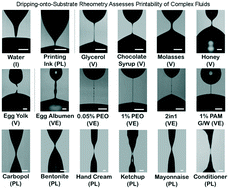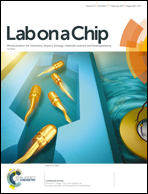Pinch-off dynamics and dripping-onto-substrate (DoS) rheometry of complex fluids†
Abstract
Liquid transfer and drop formation/deposition processes involve complex free-surface flows including the formation of columnar necks that undergo spontaneous capillary-driven instability, thinning and pinch-off. For simple (Newtonian and inelastic) fluids, a complex interplay of capillary, inertial and viscous stresses determines the nonlinear dynamics underlying finite-time singularity as well as self-similar capillary thinning and pinch-off dynamics. In rheologically complex fluids, extra elastic stresses as well as non-Newtonian shear and extensional viscosities dramatically alter the nonlinear dynamics. Stream-wise velocity gradients that arise within the thinning columnar neck create an extensional flow field, and many complex fluids exhibit a much larger resistance to elongational flows than Newtonian fluids with similar shear viscosity. Characterization of pinch-off dynamics and the response to both shear and extensional flows that influence drop formation/deposition in microfluidic and printing applications requires bespoke instrumentation not available, or easily replicated, in most laboratories. Here we show that dripping-onto-substrate (DoS) rheometry protocols that involve visualization and analysis of capillary-driven thinning and pinch-off dynamics of a columnar neck formed between a nozzle and a sessile drop can be used for measuring shear viscosity, power law index, extensional viscosity, relaxation time and the most relevant processing timescale for printing. We showcase the versatility of DoS rheometry by characterizing and contrasting the pinch-off dynamics of a wide spectrum of simple and complex fluids: water, printing inks, semi-dilute polymer solutions, yield stress fluids, food materials and cosmetics. We show that DoS rheometry enables characterization of low viscosity printing inks and polymer solutions that are beyond the measurable range of commercially-available capillary break-up extensional rheometer (CaBER). We show that for high viscosity fluids, DoS rheometry can be implemented relatively inexpensively using an off-the-shelf digital camera, and for many complex fluids, similar power law scaling exponent describes both neck thinning dynamics and the shear thinning response.



 Please wait while we load your content...
Please wait while we load your content...